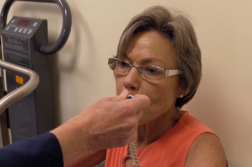WASHINGTON, DC (Ivanhoe Newswire) — One hundred thirty-five thousand Americans will die this year from lung cancer. The American Lung Association and The American Thoracic Society say as many as 25,000 could be saved annually through lung cancer screening with low dose CT scans. But according to some studies, only five percent of individuals who qualify go through the screening. And, smokers may not be aware they have a screening option.
Seventy-four-year old Jewel Tucker tries to eat right. She avoids salt and sees her doctor regularly. But she admits her main health vice was a big one … smoking.
“I started when I was 14 years old,” Tucker told Ivanhoe.
Last March, Jewel’s doctor recommended for the first time ever that she be screened for lung cancer even though she felt great and had no symptoms.
“April, they sent me a letter saying that they saw a spot on my left lung, and I needed to come in for test, you know,” continued Tucker.
That spot turned out to be cancer.
Irina Veytsman, MD, Director, Hematology/Oncology, MedStar Washington Hospital Center, said, “She underwent surgery, but during her surgery they found that she does have lymph nodes affected by her cancer.”
“They took out 12. Eleven was negative. Only one tested positive. They said I was in stage one,” exclaimed Tucker.
Dr. Veytsman says before the availability of low dose CT scans, there was no accurate way to catch lung cancer early. The American Cancer Society says patients who might benefit from low dose CT screening are between 55 and 74 years old, current smokers or those who have quit within the past 15 years, or smokers with a 30-pack-year history. A pack year is the number of years smoked multiplied by the number of packs per day.
“Most of the time we diagnose them with stage one or stage two disease, which is curable,” Dr. Veytsman said.
“If that doctor had not referred me, I’d be still smoking cigarettes, and by then I’d be in stage four and probably going away from here,” shared Tucker.
The low dose CT scan is covered by Medicare and most other insurance companies. Researchers say the one drawback is the scans sometimes find other abnormalities that do lead to additional tests. A number of earlier studies looked at chest x-ray as a screening tool, but the x-rays often did not pick up cancer until it was advanced. The National Lung Cancer screening trial confirmed the benefits of CT scans several years ago.
Contributors to this news report include: Cyndy McGrath, Producer; Roque Correa, Editor; and Kirk Manson, Videographer.
LUNG CANCER SCREENING: SOONER BETTER THAN LATER
REPORT #2747
BACKGROUND: Each year in the U.S., approximately 228,150 people are diagnosed with lung cancer and nearly 142,670 die of the disease. Smoking is the leading cause of lung cancer. Around 60 to 65% of all new lung cancer diagnoses are among people who have never smoked or have already quit smoking. Of those, about 50% are former smokers and 10 to 15% have never smoked. Lung cancer takes more lives than breast, prostate and colon cancers combined, and accounts for 25% of all cancer deaths. Men’s incidence rates began declining more than 20 years ago, while women’s rates just recently began to decline slightly, after rising for many years. African American males are known to have the highest incidence of lung cancer and the highest death rate.
(Source: https://www.lungcancerinitiativenc.org/lung-cancer-facts)
LUNG CANCER SCREENING: Lung cancer screening can help find lung cancer at an early stage when it is easier to treat. Studies have shown that a low-dose CT scan is the only lung cancer screening tool that reduces the risk of dying from lung cancer. Lung cancer is considered a serious disease because by the time you have symptoms, it has likely already spread and will become more difficult to treat. Screening is looking for cancer before you have any symptoms, which can help find cancer at an early stage when it may be easier to treat. Lung cancer screening for those at high risk needs to be part of a preventive care strategy to catch more lung cancers early and significantly improve the low survival rates. Other screening tests such as chest X-rays and sputum cytology have not been found to be effective and are not recommended for screening.
GAME-CHANGING ADVANCES FOR LUNG CANCER: University of Wisconsin Carbone Cancer Center has participated in and is leading lung cancer immunotherapy clinical trials. For patients with advanced non-small cell lung cancer (NSCLC, of which 85 percent of all lung cancers are) whose tumors test high for levels of an immune-blocking protein, PD-L1, immunotherapy was shown to be superior compared to chemotherapy. For a disease that had a five-year survival rate of only five percent for advanced stages, the addition of immunotherapy has improved that rate to 16 percent, and Ticiana Leal, MD, expects it to keep increasing. Another area of research making huge strides is in targeted therapies, and Dr. Leal calls lung cancer the “poster child” for these directed treatments in the era of precision medicine. “Our prior way of practicing was that all lung cancers are the same, and they all get treated the same way,” Leal says. “One of the breakthroughs was understanding there are alterations within tumor cells that may be driving the cancer, and more importantly that we can identify that pathway and block it with a drug.”
(Source: https://www.uwhealth.org/news/game-changing-recent-advances-in-lung-cancer-treatment/52339)
* For More Information, Contact:
So Young Pak, Director/Media Relations
(202) 877-2748
Free weekly e-mail on Medical Breakthroughs from Ivanhoe. To sign up: http://www.ivanhoe.com/ftk



